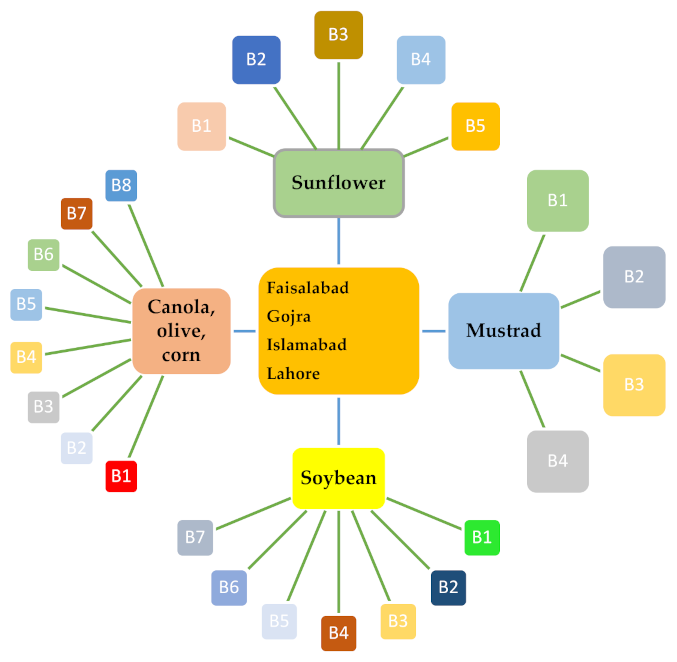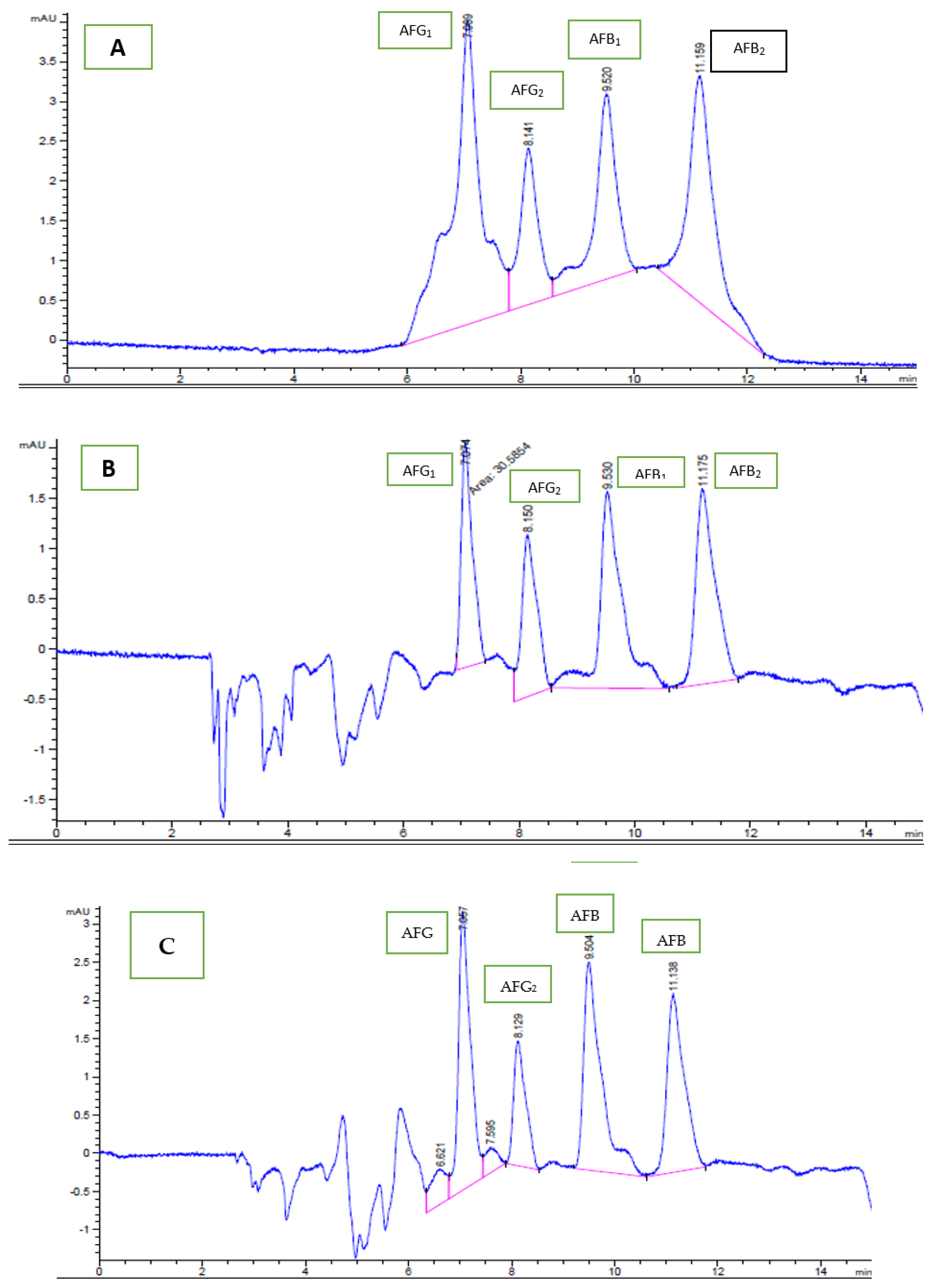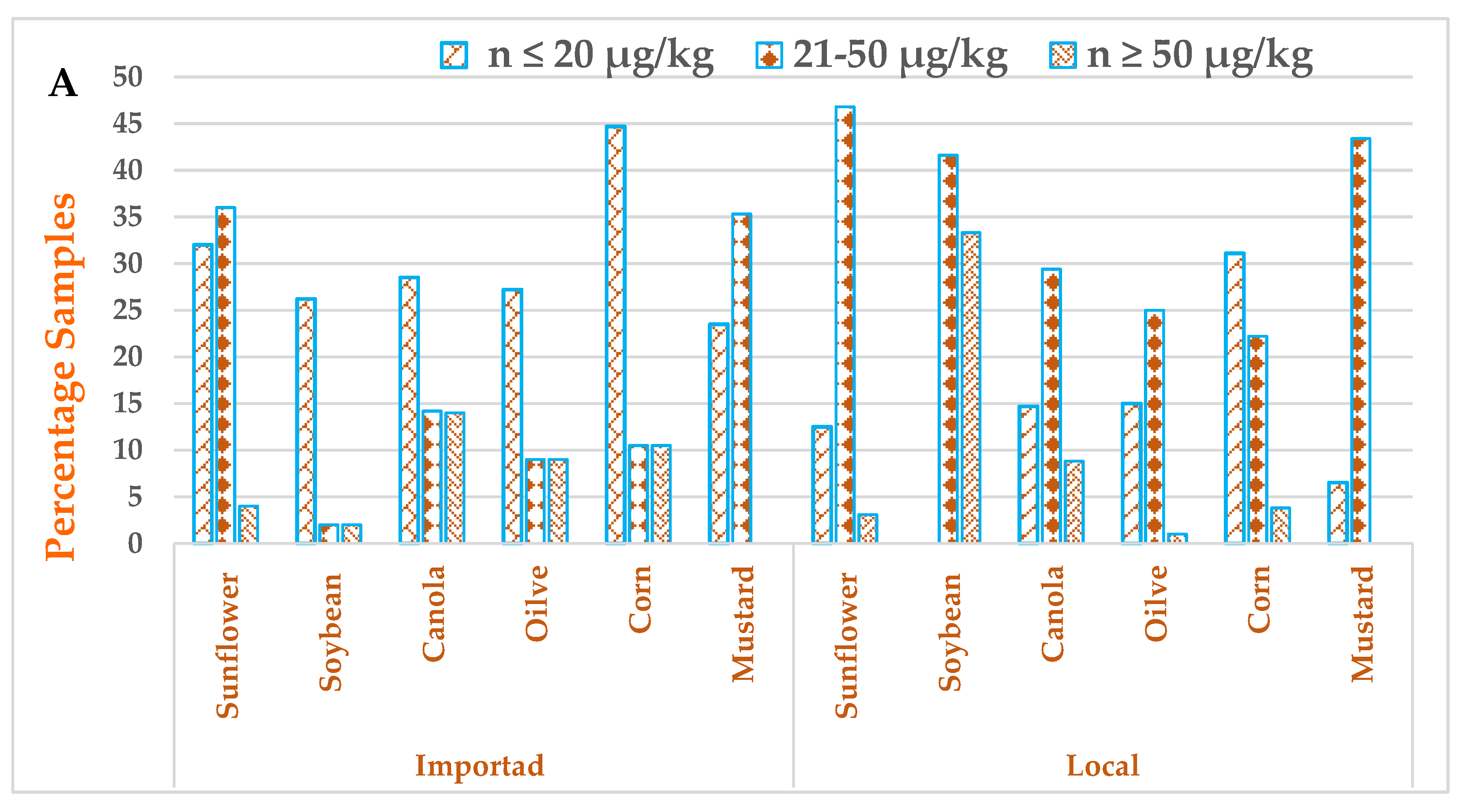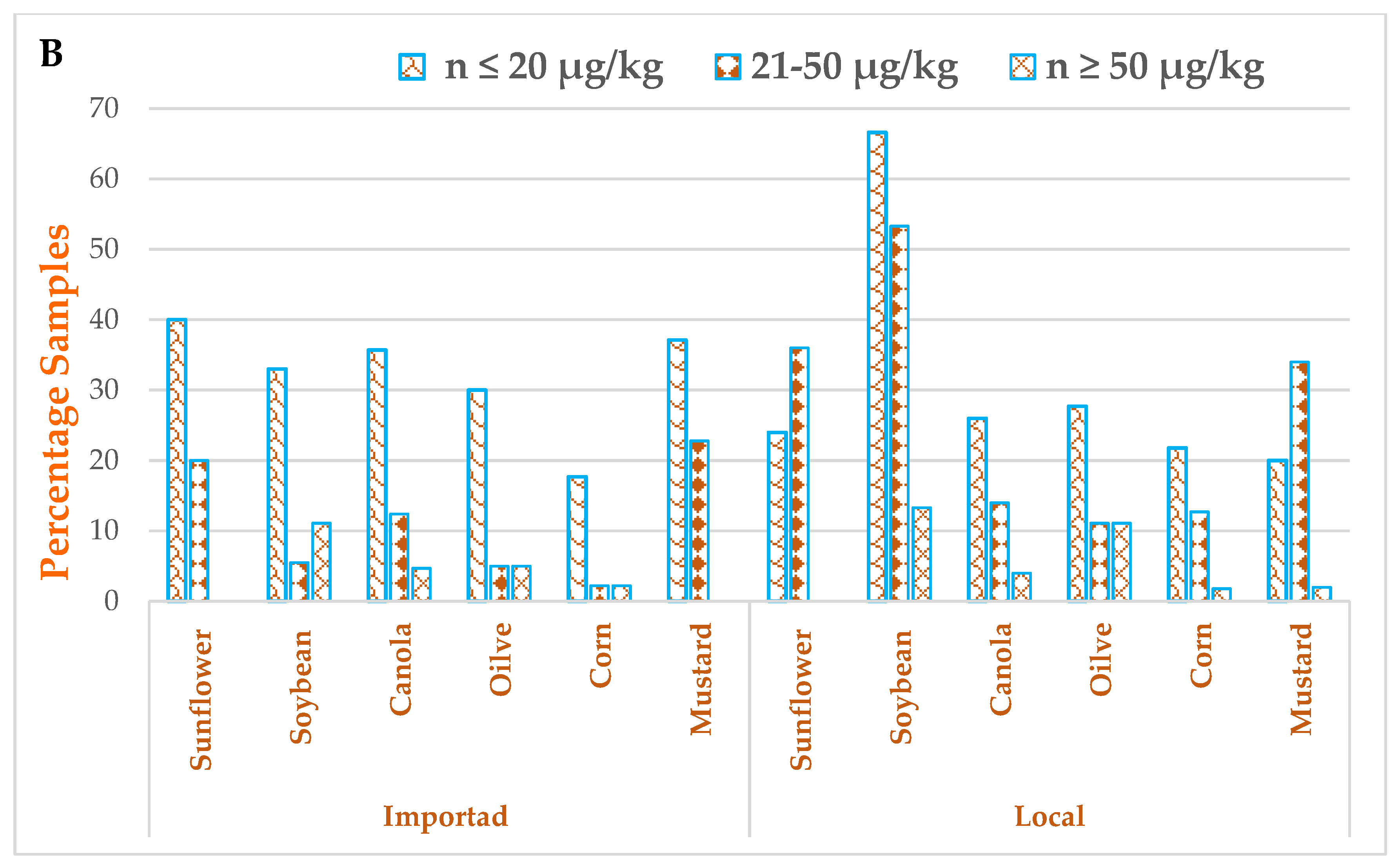Occurrence of Aflatoxins in Edible Vegetable Seeds and Oil Samples Available in Pakistani Retail Markets and Estimation of Dietary Intake in Consumers
Abstract
:1. Introduction
2. Materials and Methods
2.1. Sample Collection
2.2. Chemicals and Reagents
2.3. Extraction of Aflatoxins from Seed Samples
2.4. Extraction of Aflatoxins from Oil Samples
2.5. HPLC Conditions
2.6. Dietary Intake Estimations
2.7. Statistical Analysis
3. Results and Discussion
3.1. Quality Control Parameters
3.2. Occurrence of AFs in Edible Seeds and Oil Samples
3.3. Estimation of Dietary Intake in Sunflower Oil Samples
4. Conclusions
Supplementary Materials
Author Contributions
Funding
Institutional Review Board Statement
Informed Consent Statement
Data Availability Statement
Acknowledgments
Conflicts of Interest
References
- Krauss, R.M.; Eckel, R.H.; Howard, B.; Appel, L.J.; Daniels, S.R.; Deckelbaum, R.J.; Erdman, J.W., Jr.; Kris-Etherton, P.; Goldberg, I.J.; Kotchen, T.A.; et al. AHA dietary guidelines. Stroke 2000, 31, 2751–2766. [Google Scholar] [CrossRef] [PubMed] [Green Version]
- Cui, Y.; Hao, P.; Liu, B.; Meng, X. Effect of traditional Chinese cooking methods on fatty acid profiles of vegetable oils. Food Chem. 2017, 233, 77–84. [Google Scholar] [CrossRef] [PubMed]
- Hu, K.; Huyan, Z.; Ding, S.; Dong, Y.; Yu, X. Investigation on food packaging polymers: Effects on vegetable oil oxidation. Food Chem. 2020, 315, 126299. [Google Scholar] [CrossRef] [PubMed]
- Karunarathna, N.B.; Fernando, C.J.; Munasinghe, D.M.S.; Fernando, R. Occurrence of aflatoxins in edible vegetable oils in Sri Lanka. Food Control 2019, 101, 97–103. [Google Scholar] [CrossRef]
- FAO. Oil Crops. Food Outlook, Biannual Report on Global Food Markets. Available online: fao.org (accessed on 26 March 2021).
- FAOSTAT. 2018. Available online: http://www.fao.org/faostat/en/#rankings/countriesbycommodity (accessed on 5 November 2020).
- Kojima, Y.; Parcell, J.; Cain, J. A global demand analysis of vegetable oils for food and industrial use: A cross-country panel data analysis with spatial econometrics. In Proceedings of the Agricultural and Applied Economics Association (AAEA) Conferences, Boston, MA, USA, 31 July–2 August 2016. [Google Scholar] [CrossRef]
- Anonymous. Pakistan. Jump in Edible Oil Imports. 2018. Available online: http://www.blackseagrain.net/novosti/pakistan-jump-in-edible-oil-imports (accessed on 4 November 2020).
- Garcia, A.B. The use of data mining techniques to discover knowledge from animal and food data: Examples related to the cattle industry. Trends Food Sci. Technol. 2013, 29, 151–157. [Google Scholar] [CrossRef]
- Farré, M.; Barcelo, D.; Barceló, D. Analysis of emerging contaminants in food. TrAC Trends Anal. Chem. 2013, 43, 240–253. [Google Scholar] [CrossRef]
- Iqbal, S.Z.; Mustafa, H.G.; Asi, M.R.; Jinap, S. Variation in vitamin E level and aflatoxins contamination in different rice varieties. J. Cereal Sci. 2014, 60, 352–355. [Google Scholar] [CrossRef]
- Iqbal, S.Z.; Asi, M.R.; Jinap, S. A survey of Aflatoxin M1 contamination in milk from urban and rural farmhouses of Punjab, Pakistan. Food Addit. Contam. Part B 2014, 7, 17–20. [Google Scholar] [CrossRef]
- Iqbal, S.Z.; Asi, M.R.; Zuber, M.; Akhtar, J.; Saif, M.J. Natural occurrence of aflatoxins and ochratoxin A in commercial chilli and chilli sauce samples. Food Control 2013, 30, 621. [Google Scholar] [CrossRef]
- Iqbal, S.Z.; Asi, M.R.; Jinap, S. Natural occurrence of aflatoxin B1 and aflatoxin M1 in “Halva” and its ingredients. Food Control 2013, 34, 404–407. [Google Scholar] [CrossRef]
- Asi, M.R.; Iqbal, S.Z.; Ariño, A.; Hussain, A. Effect of seasonal variations and lactation times on aflatoxin M1 contamination in milk of different species from Punjab, Pakistan. Food Control 2012, 25, 34–38. [Google Scholar] [CrossRef]
- Iqbal, S.Z.; Asi, M.R. Assessment of aflatoxin M1 in milk and milk products from Punjab, Pakistan. Food Control 2013, 30, 235–239. [Google Scholar] [CrossRef]
- International Agency for Research on Cancer (IARC). Some naturally occurring substances: Food items and constituents, heterocyclic aromatic amines and mycotoxins. In IARC Monographs on the Evaluation of Carcinogenic Risks to Humans; IARC: Lyon, France, 1993; Volume 56, pp. 245–395. [Google Scholar]
- Iqbal, S.Z.; Asi, M.R.; Zuber, M.; Akram, N.; Batool, N. Aflatoxins contamination in peanuts and peanuts products commercially available in markets of Punjab, Pakistan. Food Control 2013, 32, 83–86. [Google Scholar] [CrossRef]
- Majeed, S.; Iqbal, M.; Asi, M.R.; Iqbal, S.Z.; Selamat, J. Analysis of nutritional traits and aflatoxin contamination in selected maize varieties from Pakistan. J. Food Prot. 2017, 80, 1993–1998. [Google Scholar] [CrossRef]
- Bordin, K.; Sawada, M.M.; da Costa Rodrigues, C.E.; da Fonseca, C.R.; Oliveira, C.A.F. Incidence of aflatoxins in oil seeds and possible transfer to oil: A review. Food Eng. Rev. 2014, 6, 20–28. [Google Scholar] [CrossRef]
- Dors, G.C.; Caldas, S.S.; Feddern, V.; Bemvenuti, R.H.; dos Santos Hackbart, H.C.; de Souza, M.M. Aflatoxins: Contamination, analysis and control. In Aflatoxins Biochemistry and Molecular Biology; IntechOpen: London, UK, 2011. [Google Scholar]
- Iqbal, S.Z.; Rabbani, T.; Asi, M.R.; Jinap, S. Assessment of aflatoxins, ochratoxin A and zearalenone in breakfast cereals. Food Chem. 2014, 157c, 257–262. [Google Scholar] [CrossRef]
- Romagnoli, B.; Menna, V.; Gruppioni, N.; Bergamini, C. Aflatoxins in spices, aromatic herbs, herb-teas and medicinal plants marketed in Italy. Food Control 2007, 18, 697–701. [Google Scholar] [CrossRef]
- Iqbal, S.Z.; Asi, M.R.; Mahmood, Z.; Mumtaz, A.; Malik, N. Survey of aflatoxins and Ochratoxin A in retail market chilies and chili sauce samples. Food Control 2017, 81c, 218–223. [Google Scholar] [CrossRef]
- Banu, N.; Muthumary, J. Aflatoxin B1 contamination in sunflower oil collected from sunflower oil refinery situated in Karnataka. Health 2010, 2, 973. [Google Scholar]
- Ferracane, R.; Tafuri, A.; Logieco, A.; Galvano, F.; Balzano, D.; Ritieni, A. Simultaneous determination of aflatoxin B1 and ochratoxin A and their natural occurrence in Mediterranean virgin olive oil. Food Addit. Contam. 2007, 24, 173–180. [Google Scholar] [CrossRef] [Green Version]
- Mariod, A.A.; Idris, Y.M.A. Aflatoxin B1 levels in groundnut and sunflower oils in different Sudanese states. Food Addit. Contam. Part B 2015, 8, 266–270. [Google Scholar]
- Samarajeewa, U.; Arseculeratne, S.N. A survey of aflatoxin contamination of coconut products in Sri Lanka; incidence, origins and recommendations. J. Nat. Sci. Found. Sri Lanka 1983, 11, 225–235. [Google Scholar] [CrossRef]
- Iqbal, S.Z.; Asi, M.R.; Zia, K.M.; Jinap, S.; Malik, N. A limited survey of aflatoxins and zearalenone in feed and feed ingredients from Pakistan. J. Food Prot. 2016, 79, 1798–1801. [Google Scholar] [CrossRef]
- Waqas, M.; Pervaiz, W.; Zia, K.M.; Iqbal, S.Z. Assessment of aflatoxin B1 in animal feed and aflatoxin M1 in raw milk samples of different species of Punjab, Pakistan. J. Food Saf. 2021, e12893. [Google Scholar] [CrossRef]
- Razis, A.F.A.; Shehzad, M.M.; Usman, S.; Ali, N.B.; Iqbal, S.Z.; Naheed, N.; Asi, M.R. Seasonal variation in aflatoxins levels in edible seeds, estimation of its dietary intake and vitamin E levels from Southern Areas of Punjab, Pakistan. Int. J. Environ. Res. Public Health 2020, 17, 8964. [Google Scholar] [CrossRef]
- Bao, L.; Liang, C.; Trucksess, M.W.; Xu, Y.; Lv, N.; Wu, Z.; Jing, P.; Fry, F.S. Determination of aflatoxins B1, B2, G1, and G2 in Olive Oil, Peanut Oil, and Sesame Oil Using Immunoaffinity column clean-up, post column derivatization, and liquid chromatography with fluorescence detection: First action 2013.05. J. AOAC Int. 2013, 96. [Google Scholar] [CrossRef]
- Shahat, M.S.; Hegaziy, A.I.; Ramzy, S.; Samie, M.A. Effect of some different technological treatments on the aflatoxins reduction in soybean seeds. Middle East. J. 2017, 6, 1426–1430. [Google Scholar]
- AOAC. International Official Methods of Analysis of AOAC International, 18th ed.; Association of Analytical Communities: Gaithersburg, MD, USA, 2008. [Google Scholar]
- Iqbal, S.Z.; Mumtaz, A.; Mehmood, Z.; Waqas, M.; Gaffar, A.; Ismail, A.; Perviz, W. Assessment of aflatoxins and ochratoxin A in chili sauce samples and estimation of dietary intake. Food Control 2021, 121, 107621. [Google Scholar] [CrossRef]
- Iqbal, S.Z.; Asi, M.R.; Mahmood, Z.; Shahid, M.; Sehar, M.; Malik, N. Co-occurrence of aflatoxins and ochratoxin A in nuts, dry fruits and nuty products. J. Food Saf. 2018, 38, e12462. [Google Scholar] [CrossRef]
- Beheshti, H.R.; Asadi, M. Aflatoxins in sunflower and safflower seeds from Iran. Food Addit. Contam. 2013, 6, 68–71. [Google Scholar] [CrossRef] [PubMed]
- Mohammed, S.; Munissi, J.J.; Nyandoro, S.S. Aflatoxins in sunflower seeds and unrefined sunflower oils from Singida, Tanzania. Food Addit. Contam. 2018, 11, 161–166. [Google Scholar] [CrossRef] [PubMed]
- Nabizadeh, S.; Shariatifar, N.; Shokoohi, E.; Shoeibi, S.; Gavahian, M.; Fakhri, Y.; Khaneghah, A.M. Prevalence and probabilistic health risk assessment of aflatoxins B1, B2, G1, and G2 in Iranian edible oils. Environ. Sci. Pollut. 2018, 25, 35562–35570. [Google Scholar] [CrossRef] [PubMed]
- Shar, Z.H.; Pirkash, O.; Shar, H.H.; Sherazi, S.T.H.; Mahesar, S.A. Aflatoxins in cotton seeds and cotton seed cake from Pakistan. Food Addit. Contam. 2020, 13, 72–76. [Google Scholar] [CrossRef] [PubMed]
- Yassa, A.I.; Abdalla, E.A.M.; Aziz, S.Y. Aflatoxin B1 production by molds isolated from black tables olives. Ann. Agric. Sci. 1994, 39, 525–537. [Google Scholar]
- Okello, D.K.; Biruma, M.; Deom, C.M. Overview of groundnuts research in Uganda: Past, present and future. Afr. J. Biotechnol. 2010, 9, 6448–6459. [Google Scholar]




| Mycotoxins | Fortified Level (µg/kg) | Recovery % | RSD % | Retention Time (min) | R2 | LOD (µg/kg) | LOQ (µg/kg) | Precision | |
|---|---|---|---|---|---|---|---|---|---|
| Repeatability (n = 5) RSD% | Reproducibility (n = 5) RSD% | ||||||||
| AFG1 | 1 | 84.5 | 9.0 | 7.074 ± 0.017 | 0.9910 | 0.08 | 0.24 | 14 | 11 |
| 6 | 91.4 | 13.5 | |||||||
| 10 | 90.5 | 14.0 | |||||||
| AFB1 | 1 | 82.5 | 12.0 | 9.530 ± 0.026 | 0.9920 | 0.08 | 0.24 | 18 | 12 |
| 6 | 94.5 | 10.0 | |||||||
| 10 | 96.5 | 21.5 | |||||||
| AFG2 | 1 | 74.5 | 18.5 | 8.150 ± 0.021 | 0.9980 | 0.07 | 0.21 | 19 | 10 |
| 4 | 89.4 | 11.5 | |||||||
| 8 | 91.5 | 16.5 | |||||||
| AFB2 | 1 | 78.5 | 12.5 | 11.175 ± 0.037 | 0.9985 | 0.07 | 0.21 | 13 | 14 |
| 4 | 94.6 | 11.1 | |||||||
| 8 | 90.5 | 14.0 | |||||||
| Sample Category | Local Samples | |||||||
|---|---|---|---|---|---|---|---|---|
| Total Sample | Positive Samples | AFB1 | Total AFs | Total Samples | Positive Samples | AFB1 | Total AFs | |
| N | N (%) | Mean (µg/kg) ± S.D. | Mean (µg/kg) ± S.D. | N | N (%) | Mean (µg/kg) ± S.D. | Mean (µg/kg) ± S.D. | |
| Sunflower | 25 | 18 (72.0) | 13.29 ± 3.5 | 20.428 ± 5.2 | 32 | 20 (62.5) | 14.23 ± 3.6 | 20.27 ± 5.4 |
| Soybean | 15 | 7 (46.6) | 10.36 ± 4.1 | 18.42 ± 4.6 | 12 | 9 (75.0) | 21.01 ± 4.7 | 36.37 ± 6.1 |
| Canola | 28 | 14 (50.0) | 9.30 ± 2.4 | 16.23 ± 3.7 | 34 | 18 (52.9) | 13.29 ± 5.6 | 20.05 ± 5.9 |
| Olive | 22 | 8 (36.3) | 5.74 ± 2.5 | 9.48 ± 1.6 | 20 | 10 (50.0) | 11.24 ± 2.5 | 16.50 ± 5.4 |
| Corn | 38 | 25 (65.7) | 10.16 ± 4.3 | 16.08 ± 2.9 | 45 | 28 (62.2) | 12.80 ± 5.3 | 19.92 ± 3.5 |
| Mustard | 34 | 20 (58.8) | 6.41 ± 2.7 | 12.95 ± 3.5 | 46 | 23 (50.0) | 8.74 ± 4.5 | 13.88 ± 4.6 |
| Total | 162 | 92 (56.7) | 189 | 108 (57.0) | ||||
| Sample Category | Local Samples | |||||||
|---|---|---|---|---|---|---|---|---|
| Total Sample | Positive Samples | Mean AFB1 | Mean AFs | Total Samples | Positive Samples | Mean of AFB1 | Mean of AFs | |
| N | N (%) | (µg/kg) ± S.D. | (µg/kg) ± S.D. | N | N (%) | µg/kg ± S.D. | µg/kg ± S.D. | |
| Sunflower | 20 | 12 (60.0) | 5.93 ± 2.3 | 11.16 ± 2.9 | 25 | 15 (60.0) | 8.7 ± 3.2 | 15.1 ± 4.3 |
| Soybean | 18 | 9 (50.0) | 6.94 ± 1.9 | 12.71 ± 4.3 | 15 | 10 (66.0) | 14.29 ± 2.5 | 25.61 ± 7.5 |
| Canola | 42 | 18 (42.8) | 4.87 ± 1.8 | 9.25 ± 3.4 | 50 | 22 (44.0) | 7.41 ± 3.4 | 11.80 ± 3.5 |
| Olive | 20 | 8 (40.0) | 4.38 ± 2.4 | 7.47 ± 2.4 | 18 | 8 (44.0) | 8.51 ± 3.5 | 12.78 ± 5.3 |
| Corn | 45 | 10 (22.0) | 2.43 ± 1.9 | 3.98 ± 1.5 | 55 | 20 (36.3) | 6.34 ± 2.8 | 8.83 ± 2.8 |
| Mustard | 35 | 21 (60.0) | 5.69 ± 2.4 | 11.56 ± 1.9 | 50 | 28 (56.0) | 7.71 ± 1.8 | 13.43 ± 4.6 |
| Total | 180 | 78 (43.3) | 213 | 103 (48.3) | ||||
| Category | Type | Males | Females | ||||
|---|---|---|---|---|---|---|---|
| Age Groups | Age Groups | ||||||
| 16–22 | 23–32 | ≥33 | 16–22 | 23–32 | ≥33 | ||
| Imported | Consumption mg/day | 2.7 | 2.2 | 2.1 | 2.5 | 2.1 | 1.9 |
| AFs mean level (µg/kg) | 11.16 | 11.16 | 11.16 | 11.16 | 11.16 | 11.16 | |
| Dietary Intake µg/kg/day | 0.49 | 0.32 | 0.25 | 0.57 | 0.43 | 0.33 | |
| Local | Consumption mg/day | 2.8 | 2.4 | 2.1 | 2.9 | 2.2 | 2.0 |
| AFs mean level (µg/kg) | 15.1 | 15.1 | 15.1 | 15.1 | 15.1 | 15.1 | |
| Dietary Intake µg/kg/day | 0.69 | 0.48 | 0.33 | 0.90 | 0.58 | 0.45 | |
Publisher’s Note: MDPI stays neutral with regard to jurisdictional claims in published maps and institutional affiliations. |
© 2021 by the authors. Licensee MDPI, Basel, Switzerland. This article is an open access article distributed under the terms and conditions of the Creative Commons Attribution (CC BY) license (https://creativecommons.org/licenses/by/4.0/).
Share and Cite
Waqas, M.; Iqbal, S.Z.; Abdull Razis, A.F.; Pervaiz, W.; Ahmad, T.; Usman, S.; Ali, N.B.; Asi, M.R. Occurrence of Aflatoxins in Edible Vegetable Seeds and Oil Samples Available in Pakistani Retail Markets and Estimation of Dietary Intake in Consumers. Int. J. Environ. Res. Public Health 2021, 18, 8015. https://doi.org/10.3390/ijerph18158015
Waqas M, Iqbal SZ, Abdull Razis AF, Pervaiz W, Ahmad T, Usman S, Ali NB, Asi MR. Occurrence of Aflatoxins in Edible Vegetable Seeds and Oil Samples Available in Pakistani Retail Markets and Estimation of Dietary Intake in Consumers. International Journal of Environmental Research and Public Health. 2021; 18(15):8015. https://doi.org/10.3390/ijerph18158015
Chicago/Turabian StyleWaqas, Muhammad, Shahzad Zafar Iqbal, Ahmad Faizal Abdull Razis, Wajeeha Pervaiz, Touheed Ahmad, Sunusi Usman, Nada Basheir Ali, and Muhammad Rafique Asi. 2021. "Occurrence of Aflatoxins in Edible Vegetable Seeds and Oil Samples Available in Pakistani Retail Markets and Estimation of Dietary Intake in Consumers" International Journal of Environmental Research and Public Health 18, no. 15: 8015. https://doi.org/10.3390/ijerph18158015
APA StyleWaqas, M., Iqbal, S. Z., Abdull Razis, A. F., Pervaiz, W., Ahmad, T., Usman, S., Ali, N. B., & Asi, M. R. (2021). Occurrence of Aflatoxins in Edible Vegetable Seeds and Oil Samples Available in Pakistani Retail Markets and Estimation of Dietary Intake in Consumers. International Journal of Environmental Research and Public Health, 18(15), 8015. https://doi.org/10.3390/ijerph18158015










